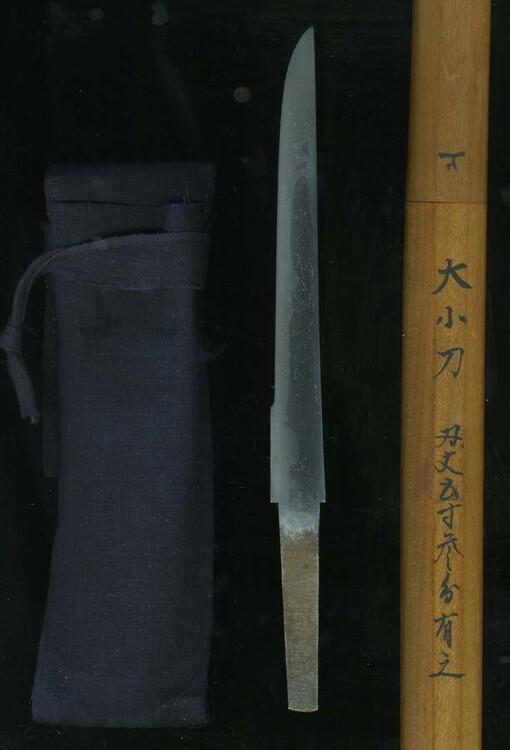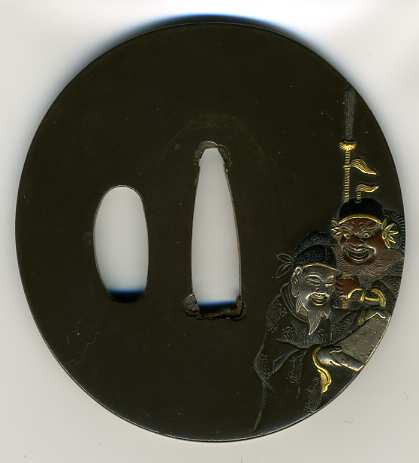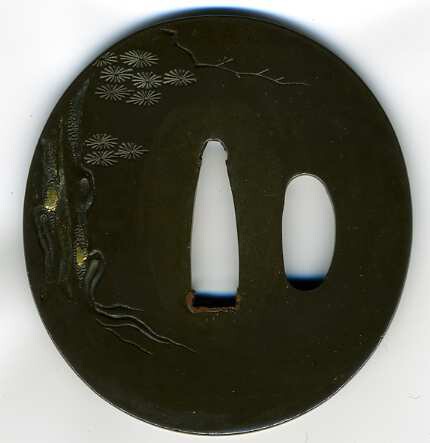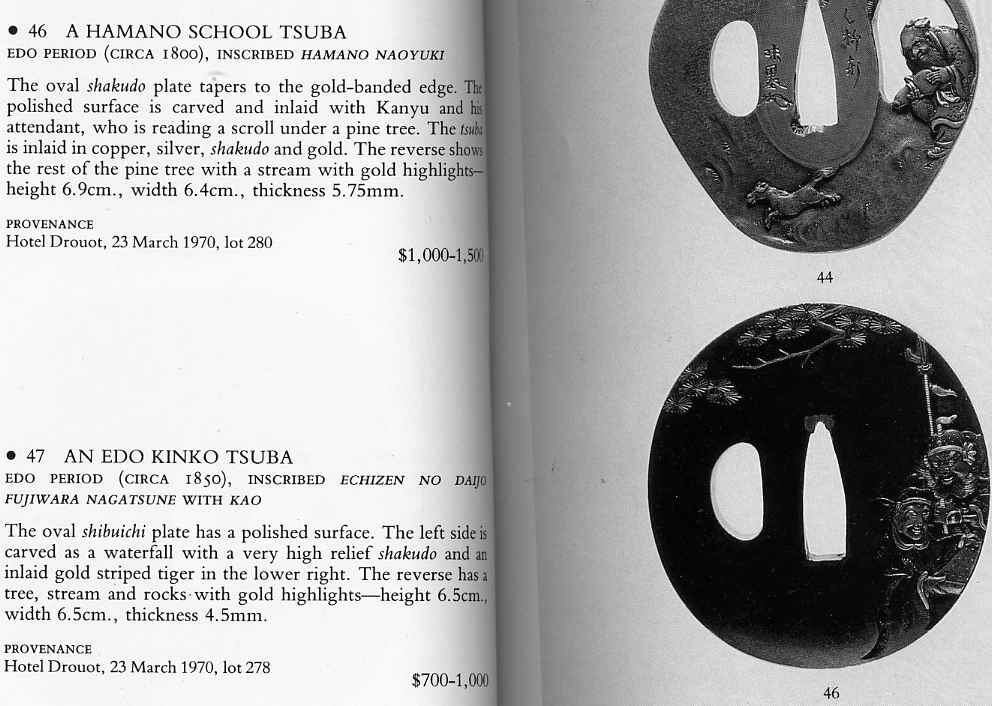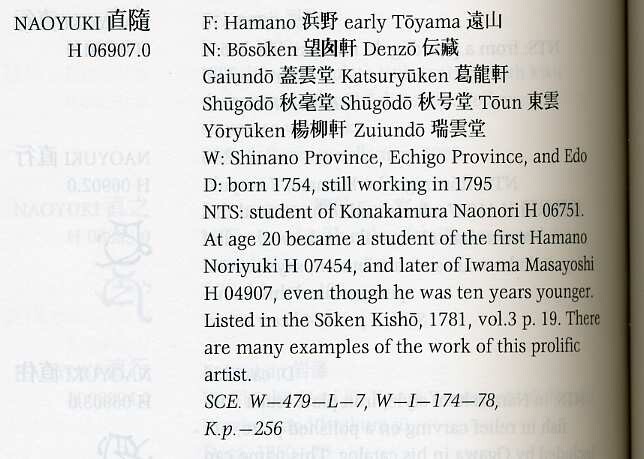-
Posts
4,308 -
Joined
-
Last visited
-
Days Won
21
Everything posted by Curran
-
RKG did a superb job of getting many many major points into one post. Tough act to follow. Only advice to stress: Try and get involved with a reputable sword club. Given that you are a relative newbie, you are already looking at some decent sword. But bide your time and determine what interests you.
-
Jan, Consider submitting it as a complete koshirae. My understanding is they will not be authenticating the signature of each individual piece, but authenticating it as a complete work of antiquity. In the photos I can see, it looks very nice. If you have a photo of the whole piece, I'd love to see it.
-
Nice looking rig of fittings. Ichiryu Michitoshi is also listed in Haynes. Just a short entry. So no pointer to a reference signature in any of the main texts. If submitted, almost no reason for it to be a gimei- but then no compelling reason for them to guarantee it as authentic. I don't know if they would paper it or not.
-
The symbology of Pine needles- In Japanese art they often appear as one broken & one normal. This is a symbol of loyalty and fidelity. Even broken - the broken needle- (even in death) you are not alone, but rather paired with another. This is your pairing with your lord, your daimyo, your superior, your wife, and those underneath you. Thats the idea. Curran
-
Work by Hirata Kunishige. His work is prolific, and to complicate matters- there are many gimei of his work. Very easy to copy.
-

new sword enthusist _buys fakes
Curran replied to bob scruggs's topic in Auctions and Online Sales or Sellers
Where are you located in Florida? There are a good number of collectors in FL. There is also the Tampa sword show in February- which would be very educational to you. Curran -
Real, but a late late Edo or Meiji/Showa cast of a Soten (or derivative school). They have some minimal worth, but not much. I purchased a tsuba from blurry ebay photos. It turned out to be a cast. So I offered it as "cast tsuba" with full disclosure and priced it at about 1/2 of what I paid. I thought even that was a tad aggressive, but people still wanted it. Went fast. I do not know anything about the coin you posted.
-
Ford, Yes, a modern. I thought it was one produced by a Japanese gentleman that I've seen on video turn out a few. One must be careful, because they pop up for auction in Japan. Sometimes the photo angles make it difficult to tell they are moderns.
-
Owari feel. Squared off mimi w/ masame grain lines, sort of pseudo Yagyu. Smaller compact size. Think "Ono" shop. A bit on the crude side but clean cut side for Ono. My guess is later... Mid Edo, maybe. Maybe someone else (*ahem* -cough, cough- you know who you are...) would like to show their good example of an Ono tsuba. I could slice bread with the masame grain lines in that one. Cool thing is they go very clearly all the way through the tsuba.
-
Apolgies in advance. I am zapped from a long work day and family obligations... -so this may be less than lucid. To answer Ken- Quick European blades: handled a few Italian dueling rapiers that I could could make move nearly as well as a sport fencing Epee. A gent who lives nearby in his half-castle has a nice rapier with a German made blade that feels well too, though requires more finger strength. Has a very heavy weight on the butt of the pommel. Rich T, I believe commented on the short life of the straight sword? I was more just thinking of the benefits of a straighter sword. This one http://www.nihontocraft.com/Murata_Tsun ... atana.html popped up for sale today and is supposedly a homage piece to the famous historical sword "little crow", but looks slimmer to me. How different is it from the slight bend many of us fencer place (or placed- not much fencing in my neck of the woods these days) on our Epee? Hope that made some sense. Off to bed for me.
-
Ken, That too is a long discussion. Short answer is the Japanese fencing schools sprung up during the 1600s and blade shape of real swords straightened out to more closely match their practice counterparts. The front of the blade became better suited for thrusting. More of a rise in unarmored dueling (my school vs. your school). Since my experience with kendo is limited to 1 year of active participation with a college kendo team, I don't think I have adequate basis to athletically cross compare and well put it into words. From an Art viewpoint: as much as I love the graceful arc and active hamon of Oei Bizen, sometimes the mild sori and quickness of a balanced shinto blade has a working appeal to my western brain, -yet it is Art in hand. It feels like the best of a sabre and rapier rolled into one.
-
Ken, That is a very big question. Like most things philisophical, answers will vary depending on who you ask. Our well spoken alumnus Darcy (who occassionally pops his head into the forum) would have said, "Collect the best you can afford". I agree with him, though I would dwell on the points that the _best_you_can_afford_ can change with time and should be the best of what speaks to your eye and your feel. I distinctly prefer my c. 1350-1425 Bizen and Yamashiro, but have always tried to keep the eyes open and relaxed to see what jumps out at me. I've been enticed by some earlier Yamato tanto, an Owari-Seki sword or two, a few Hizento, Sukehiro, late Gassan work, and even one or two Yasukunito. Oh- and a crazy little Echizen shinshinto yoroi-doshi tanto. That is a fairly broad scatter pattern. My opinion is Owari-seki is one of the best bang for the buck buys among the shinto schools. There are several popular shinto schools that just don't yield me satisfaction, and are quite expensive. Given that you are a fencer, some of the 1600s Edo schools will very much appeal to you. That's my opinion, having done a a year or two of kendo, and fenced Foil and Epee for quite a number of years.
-
Ken, Finding that wak with NBTHK papers for what you called a fair price- is a good find. I say that with a touch of envy. I liked the photos. The blade looks to be in very good polish. As John said, Owari-seki does get to be a sort of shinsa dumping ground for blades that meet certain characteristics, but are unsigned. I think that brings the Owari-seki down in overall stature, but the Owari blade geometry, hard dark iron w/ active and visible grain, and strong hamon temper usually with healthy sprinkling of large nie- it all appeals to me in a way that many shinto blades do not. John- I'll put a note with it, should I ever decide to sell it. I have the random days when I think to sell off my last non fittings (a tanto, an arrowhead, and this o-kogatana). As an O-kogatana- it was probably made to accompany a massive shrine dedication sword c. 1600. If you figure out how to input the Mino Taikan, I have about a half dozen other books that could use your leap of technology.
-
A good underated school. Some people have a special love for this school and collect only this. John Stuart seems to have put together some nice information on them. There isn't much out there in English beyond the texts Ludolph recommended, and I've never tried to translate the Mino Taikan infromation. If Mr. Stuart tackles that, I'll be first in line to try and get a copy. I have very few blades left, but keep this one Jumyo O-kogatana (see picture). It was featured in Bushido magazine many years ago, and is about the size of a nice little tanto. On a whim, I papered it one year- and it came back to "earliest Edo" Jumyo. That was fairly close to how I pegged it. Good enough. A very fun little piece. Some of the Owari Seki Nobutaka blades can be such very beautiful works.
-
KM, I'd found the Sassa reference via another website, but wasn't sure it was correct. I have not had time this evening to research the family. Stein's website has been down all day, so your link didn't work for me- but I am very thankful to know the name "Katsumoto" as I hadn't been able to find anything for that mon. Thanks again- Curran
-
This tsuba is signed 'Isso' with kao and has NBTHK Hozon papers. He was an interesting fellow, who had Isshi as a teacher and was assistant to Ichijo. Later in life he was a retainer to the Kii branch of the Tokugawa family. I would like to identify to identify the family Mon on the tsuba. I have not yet found a good online reference, though I know it must exist. Can anyone help identify the two mon?
-
Peter Klein recently pointed to a set of the NBTHK "green papers" that were obviously wrong. There was a problem in the late 70s with illegitimate papers being issued by a branch (or some of the branches) of the NBTHK. I do not recall the specifics, but am cautious of anything dated 1976 or later. That cuts two ways: up till 1972 (?) the Green Papers were the highest non Juyo that the NBTHK issued. But so many people are OH MY - THE QUESTIONABLE GREEN PAPERS !! and that is all they know.... that it is often easy to check the date (I love the old pre-1972 green papers) and hem and hawh about "dubious" green papers to get the price down. I confess- I have done it. Occassionally the item (usually a tsuba in my case) comes back with Kanteisho or Hozon papers to something other what the green papers said. But that can happen with some items submitted more than once for Hozon (different shinsa, different paper). Is the sword signed?
-
Gassan habaki might tell you something, but then most Gassan blades are so distinct as to already tells you it is a Gassan. I do not know much about Gassan habaki. Would be nice if Mr. Tschernaga wanted to educate us further- but on 99.9% of the swords out there, it is as Brian said: no correlation.
-
Nice tsuba! Tosho, I think. More photos would help. But I would hazzard a guess of Momoyama or early Edo? The mimi and (now plugged) kozuka ana were added (and plugged) later. Good old iron piece.
-
Tempo (Tembo if you want to say it that way) tsuba. Hot stamps. Lead plugs. Looks perfectly fine to me. More than a few of your high end Nobuiye have lead plugs. Good buy if you got it for cheap. Leave it alone or carry it around in your pocket for a while. Don't try and clean the crags at all, unless the crud is aggressive red rust.... even then- practice on 15 or 20 other tsuba to develop your feel for such work before you tackle this one.
-

Tsuba for Sale & Tsuba wanted
Curran replied to Curran's topic in Auctions and Online Sales or Sellers
List, All listed tsubas are gone. The fuchi/kashira remains, and I have the last (& best, a pristine signed Hamano) tsuba to list when I have more time. Email me if anyone wants photos. Otherwise, I will post here when time allows. Curran -

Tsuba for Sale & Tsuba wanted
Curran replied to Curran's topic in Auctions and Online Sales or Sellers
Okay, the next one: Hamano Naoyuki tsuba $1100 --------------SOLD------------- See the Comptons Collection Vol #3 reference for an very similar one. This one I am selling came out of a museum collection. Museum numbers inside the nakago ana. Condition is near pristine. Comparable ones are out there right now at $3000+ and $1700+ on dealer sites. Again, condition is near pristine. Tsuba is, of course, very 3-D. The scanner cannot pick it up. Curran -
Gang, in the sales section I am graduating a part of my tsuba collection. Most all are non-sukashi pieces that I have enjoyed studying. As far as I am concerned, they are open to discussion- as each one had enough to teach me that I held onto them for a while. I'll be posting more tsuba over the course of the next few days. I will go so far as to guarantee each piece for papers if people chose to submit to the upcoming NTHK shinsa. Natuarally, some already have papers- but if you want to submit again, sure.. Ps. Always willing to consider/work trades on papered ko-Akasaka tsuba Curran


